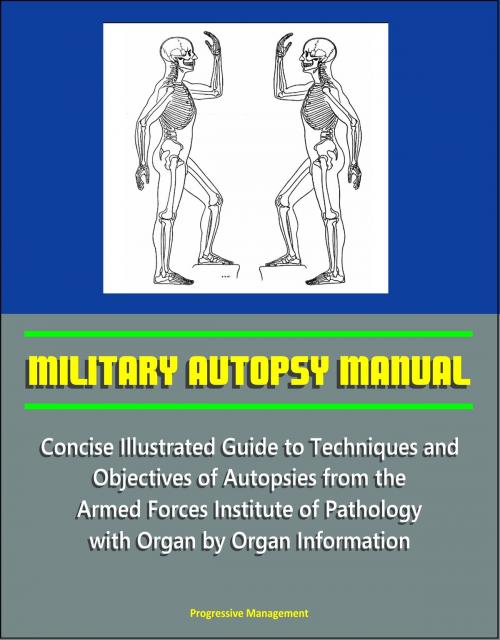Military Autopsy Manual: Concise Illustrated Guide to Techniques and Objectives of Autopsies from the Armed Forces Institute of Pathology, with Organ by Organ Information
Nonfiction, Health & Well Being, Medical, Specialties, Forensic Medicine, History, Military, United States| Author: | Progressive Management | ISBN: | 9781310551345 |
| Publisher: | Progressive Management | Publication: | August 27, 2014 |
| Imprint: | Smashwords Edition | Language: | English |
| Author: | Progressive Management |
| ISBN: | 9781310551345 |
| Publisher: | Progressive Management |
| Publication: | August 27, 2014 |
| Imprint: | Smashwords Edition |
| Language: | English |
This ebook provides a reproduction of the multiservice Autopsy Technical Manual (TM 8-300, NAVMED P-5065, AFM 160-19), prepared by the Armed Forces Institute of Pathology. This revised and illustrated manual provides a ready and concise criteria on postmortem procedures and examinations. Its publication is presented as a guiding directive toward uniformity in the selected techniques and objectives of an autopsy. It contains new information concerning cytogenic analysis, electron microscopy, examination of the oral cavity and postmortem chemistries. Though this manual is issued primarily to meet the requirements of the Armed Forces, its value could well extend into civilian laboratories and civilian medicine.
Contents include: Technique Of The Autopsy: Preparatory Measures, Inspection, Incision of Thorax and Abdomen, Skin, Peritoneal Cavity and Abdominal Organs, Fluid in Peritoneal Cavity, Exposure and Inspection of the Thoracic Viscera, Pleural Cavities, Thoracic Duct, Pericardial Cavity, Superior Mediastinum * External examination and body cavities * General principles in dissection and examination of the viscera * Organ by organ removal: Heart, Trachea and Bronchi, Lungs, Larynx, Pharynx, Hypopharynx, Tongue, Thyroid, Parathyroid, Oral Cavity, Mesentery and Intestine, Spleen, Lymph Nodes, Gallbladder, Bile Ducts, Esophagus, Stomach, Duodenum, Pancreas, Liver, Adrenal Glands, Aorta, Urinary Tract, Kidneys, Urinary Bladder, Prostate, Rectum and Sigmoid, Seminal Vesicles, Testes, Female Genitalia and Breasts, Removal and Examination of the Brain, Removal of the Eyes, Spinal Cord, Examination of Nerves, Bones, Cartilage, Joints, Ribs, Extremities, Knee Joint, more * Removal of the viscera en masse (Rokitansky Method) * Pediatric Autopsies With Special Reference To Infants And Fetuses * Aircraft Accident Autopsies * Special Procedures * Descriptive Protocol * Examination for microorganisms * Special studies of viral diseases * Immunological examination * Radioactive cadavers and specimens * Collection and shipment of specimens for toxicological examination * Cytogenetic analysis * Fixation of tissue for electron microscopy * Postmortem chemistry * Photography * Objectives Of The Medicolegal Autopsy * Selection And Preservation Of Tissue For Further Study And Museum Purposes * Fixation of blocks for microscopic study * Preservation by deep freezing for bacteriological, serological, and hormone study * Preservation of tissues for museum purposes.
The introduction defines an autopsy as a scientific postmortem examination of a dead body, performed to reveal the presence of pathologic processes, their relation to clinical phenomena and history, and to determine the cause or causes of the changes encountered. A medicolegal autopsy is a specialized type of autopsy authorized or ordered by proper legal authorities in cases of accidental, suicidal, homicidal, unattended, or unexpected deaths for the purpose of determining the cause and manner of death in order to protect society and insure the administration of justice. Whatever type of autopsy is performed, the examination should not be restricted to only those areas which are the seat of obvious alteration, but should include all the organs of the body, for the normality of certain viscera is often as significant as the disease of others, and organs that appear normal macroscopically are frequently abnormal microscopically. An exception to the foregoing is where the authority to conduct the autopsy derives from the consent of the next-of-kin and such consent has limited the extent of the autopsy.
This ebook provides a reproduction of the multiservice Autopsy Technical Manual (TM 8-300, NAVMED P-5065, AFM 160-19), prepared by the Armed Forces Institute of Pathology. This revised and illustrated manual provides a ready and concise criteria on postmortem procedures and examinations. Its publication is presented as a guiding directive toward uniformity in the selected techniques and objectives of an autopsy. It contains new information concerning cytogenic analysis, electron microscopy, examination of the oral cavity and postmortem chemistries. Though this manual is issued primarily to meet the requirements of the Armed Forces, its value could well extend into civilian laboratories and civilian medicine.
Contents include: Technique Of The Autopsy: Preparatory Measures, Inspection, Incision of Thorax and Abdomen, Skin, Peritoneal Cavity and Abdominal Organs, Fluid in Peritoneal Cavity, Exposure and Inspection of the Thoracic Viscera, Pleural Cavities, Thoracic Duct, Pericardial Cavity, Superior Mediastinum * External examination and body cavities * General principles in dissection and examination of the viscera * Organ by organ removal: Heart, Trachea and Bronchi, Lungs, Larynx, Pharynx, Hypopharynx, Tongue, Thyroid, Parathyroid, Oral Cavity, Mesentery and Intestine, Spleen, Lymph Nodes, Gallbladder, Bile Ducts, Esophagus, Stomach, Duodenum, Pancreas, Liver, Adrenal Glands, Aorta, Urinary Tract, Kidneys, Urinary Bladder, Prostate, Rectum and Sigmoid, Seminal Vesicles, Testes, Female Genitalia and Breasts, Removal and Examination of the Brain, Removal of the Eyes, Spinal Cord, Examination of Nerves, Bones, Cartilage, Joints, Ribs, Extremities, Knee Joint, more * Removal of the viscera en masse (Rokitansky Method) * Pediatric Autopsies With Special Reference To Infants And Fetuses * Aircraft Accident Autopsies * Special Procedures * Descriptive Protocol * Examination for microorganisms * Special studies of viral diseases * Immunological examination * Radioactive cadavers and specimens * Collection and shipment of specimens for toxicological examination * Cytogenetic analysis * Fixation of tissue for electron microscopy * Postmortem chemistry * Photography * Objectives Of The Medicolegal Autopsy * Selection And Preservation Of Tissue For Further Study And Museum Purposes * Fixation of blocks for microscopic study * Preservation by deep freezing for bacteriological, serological, and hormone study * Preservation of tissues for museum purposes.
The introduction defines an autopsy as a scientific postmortem examination of a dead body, performed to reveal the presence of pathologic processes, their relation to clinical phenomena and history, and to determine the cause or causes of the changes encountered. A medicolegal autopsy is a specialized type of autopsy authorized or ordered by proper legal authorities in cases of accidental, suicidal, homicidal, unattended, or unexpected deaths for the purpose of determining the cause and manner of death in order to protect society and insure the administration of justice. Whatever type of autopsy is performed, the examination should not be restricted to only those areas which are the seat of obvious alteration, but should include all the organs of the body, for the normality of certain viscera is often as significant as the disease of others, and organs that appear normal macroscopically are frequently abnormal microscopically. An exception to the foregoing is where the authority to conduct the autopsy derives from the consent of the next-of-kin and such consent has limited the extent of the autopsy.















